Real-Time Optimization by
Extremum-Seeking Control
�
Real-Time Optimization by
Extremum-Seeking Control
KARTIK B. ARIYUR
MIROSLAV KRSTIC´
A JOHN WILEY & SONS, INC., PUBLICATION
�
Copyright © 2003 by John Wiley & Sons, Inc. All rights reserved.
Published by John Wiley & Sons, Inc., Hoboken, New Jersey.
Published simultaneously in Canada.
No part of this publication may be reproduced, stored in a retrieval system or transmitted in any form or
by any means, electronic, mechanical, photocopying, recording, scanning or otherwise, except as
permitted under Section 107 or 108 of the 1976 United States Copyright Act, without either the prior
written permission of the Publisher, or authorization through payment of the appropriate per-copy fee to
the Copyright Clearance Center, Inc., 222 Rosewood Drive, Danvers, MA 01923, (978) 750-8400, fax
(978) 750-4470, or on the web at www.copyright.com. Requests to the Publisher for permission should
be addressed to the Permissions Department, John Wiley & Sons, Inc., 111 River Street, Hoboken, NJ
07030, (201) 748-6011, fax (201) 748-6008, e-mail: permreq@wiley.com.
Limit of Liability/Disclaimer of Warranty: While the publisher and author have used their best efforts in
preparing this book, they make no representation or warranties with respect to the accuracy or
completeness of the contents of this book and specifically disclaim any implied warranties of
merchantability or fitness for a particular purpose. No warranty may be created or extended by sales
representatives or written sales materials. The advice and strategies contained herein may not be
suitable for your situation. You should consult with a professional where appropriate. Neither the
publisher nor author shall be liable for any loss of profit or any other commercial damages, including
but not limited to special, incidental, consequential, or other damages.
For general information on our other products and services please contact our Customer Care
Department within the U.S. at 877-762-2974, outside the U.S. at 317-572-3993 or fax 317-572-4002.
Wiley also publishes its books in a variety of electronic formats. Some content that appears in print,
however, may not be available in electronic format.
Library of Congress Cataloging-in-Publication Data:
Ariyur, Kartik B.
Real-time optimization by extremum-seeking control / Kartic B. Ariyur, Miroslav Kristic´.
p. cm.
“A Wiley-Interscience publication.”
Includes bibliographical references and index.
ISBN 0-471-46859-2 (cloth)
1. Adaptive control systems.
I. Kristic´, Miroslav.
II.Title.
TJ217.A665 2003
629.8⬘36—dc21
Printed in the United States of America.
10 9 8 7 6 5 4 3 2 1
2003053460
�
Contents
Preface
I THEORY
1 SISO Scheme and Linear Analysis
1.1 Extremum Seeking for a Static Map
1.2 Single Parameter Extremum Seeking
for Plants with Dynamics
1.2.1 Single Parameter LTV Stability Test
1.2.2 Single Parameter LTI Stability Test
1.2.3 Single Parameter Compensator Design
1.3 Single Parameter Example
Notes and References
2 Multiparameter Extremum Seeking
2.1 Output Extremization in Multiparameter Extremum Seeking
2.1.1 Multivariable LTV Stability Test
2.1.2 Multivariable LTI Stability Test
2.2 Multiparameter Design
2.3 Multiparameter Simulation Study
2.3.1 Step Variations in B*(t) and f*(t)
2.3.2 General Variations in B*(t) and f*(t)
Notes and References
3 Slope Seeking
3.1 Slope Seeking on a Static Map
3.2 General Single Parameter Slope Seeking
3.3 Compensator Design
3.4 Multiparameter Gradient Seeking
Notes and References
v
ix
1
3
4
6
8
11
17
18
19
21
21
23
26
34
39
40
41
43
4 7
48
50
57
58
60
�
vi
CONTENTS
4 Discrete Time Extremum Seeking
4.1 Discrete-Time Extremum Seeking Control
4.2 Closed-Loop System
4.3 Stability Analysis
4.4 Example
Notes and References
5 Nonlinear Analysis
5.1 Extremum Seeking: Problem Statement
5.2 Extremum Seeking Scheme
5.3 Averaging Analysis
5.4 Singular Perturbation Analysis
Notes and References
6 Limit Cycle Minimization
6.1 Scheme for Limit Cycle Minimization
6.2 Vander Pol Example
6.3 Analysis
Notes and References
II APPLICATIONS
7 Antilock Braking
7.1 Model of a Slipping Wheel
7.2 ABS via Extremum Seeking
Notes and References
8 Bioreactors
8.1 Dynamic Model of a Continuous Stirred Tank Reactor
8.2 Optimization Objective
8.3 Bifurcation Analysis of the Open-Loop System
8.3.1 Monad Model
8.3.2 Haldane Model
8.4 Extremum Seeking via the Dilution Rate
8.4.1 Monod Model
8.4.2 Haldane Model
8.5 Feedback with Washout Filters for the Haldane Model
8.5.1 Control Design
8.5.2 Simulation Results
Notes and References
61
61
62
65
68
69
71
71
72
74
77
79
81
81
82
84
89
91
93
93
95
96
99
100
102
102
102
104
106
107
108
109
110
111
112
�
CONTENTS
Vll
9 Formation Flight
9.1 Wingman Dynamics in Close Formation Flight
9.1.1 Wake Model
9.1.2 Forces and Moments on the Wingman in the Wake
9.1.3 Wingman Equilibrium in the Wake
9.1.4 Wingman Dynamics in the Wake
119
122
122
124
126
127
129
133
9.3.1 Formulation as a Standard Extremum Seeking Problem 133
137
9.3.2 Extremum Seeking Design for Formation Flight
138
141
9.2 Formation-Hold Autopilot
9.3 Extremum Seeking Control of Formation Flight
9.4 Simulation Study
Notes and References
10 Combustion Instabilities
10.1 Identification of Averaged Pressure Magnitude Dynamics
10.2 Controller Phase Tuning via Extremum-Seeking
10.3 Experiments with the Adaptive Algorithm
10.4 Instability Suppression during Engine Transient
Notes and References
11 Compressor Instabilities: Part I
11.1 Model Derivation
11.2 Equilibria in the E-MG3 Model
11.3 Skewness
11.4 Open-Loop Bifurcation Diagrams
11.5 Pre-Control Analysis: Critical Slopes
11.6 Control Design
11.6.1 Enforcing a Supercritical Bifurcation
11.6.2 Linearization at a Stall Equilibrium
11.6.3 Stability at the Bifurcation Point
11.7 Pressure Peak Seeking for the Surge Model
11.8 Peak Seeking for the Full Moore-Greitzer Model
11.9 Simulations for the Full MG Model
Notes and References
12 Compressor Instabilities: Part II
12.1 Extremum Seeking on the Caltech Rig
12.1.1 Actuation for Stall Stabilization
12.1.2 Filter Design
12.2 Experimental Results
12.2.1 Initial Point on the Axisymmetric Characteristic
12.2.2 Initial Point on the Nonaxisymmetric Characteristic
12.3 Near Optimal Compressor Operation via Slope Seeking
Notes and References
143
144
146
149
152
154
157
160
163
164
165
167
169
170
172
176
176
178
181
184
187
187
189
190
191
191
191
194
196
�
viii
Appendices
A Continuous Time Lemmas
B Discrete Time Lemmas
C Aircraft Dynamics in Close Formation Flight
C.l C-5 and Flight Condition Data
C.2 Wake-Induced Velocity Field
C.3 Free Flight Model Data
C.4 Formation Flight Model: Influence Matrices
C.5 Formation-Hold Autopilot Parameters
D Derivation of Equations {11.8) and (11.10)
E Derivation of the Critical Slopes
F Proof of Lemma 11.1
Bibliography
Index
CONTENTS
199
201
203
207
207
207
208
210
210
213
217
219
223
235
�
Preface
Extremum seeking, a popular tool in control applications in the 1940s-1960s,
has seen a return as an exciting research topic and industrial real-time opti
mization tool in the 1990's. Extremum seeking is also a method of adaptive
control but it does not fit into the classical paradigm or model reference and
related schemes, which deal with the problem of stabilization of a known ref
erence trajectory or set point.
A second distinction between classical adaptive control and extremum seek
ing is that the latter is not model based. As such, it provides a rigorous, high
performance alternative to control methods involving neural networks.
Its
non-model based character explains the resurgence in popularity of extremum
seeking in the last half a decade: the recent applications in fluid flow, com
bustion, and biomedical systems are all characterized by complex, unreliable
models.
Extremum seeking is applicable in situations where there is a nonlinear
ity in the control problem, and the nonlinearity has a local minimum or a
maximum. The nonlinearity may be in the plant, as a physical nonlinearity,
possibly manifesting itself through an equilibrium map, or it may be in the
control objective, added to the system through a cost functional of an opti
mization problem. Hence, one can use extremum seeking both for tuning a
set point to achieve an optimal value of the output, or for tuning parameters
of a feedback law. The parameter space can be multivariable, a case we cover
extensively in this book.
This book overviews the efforts made over the last seven years to put
extremum seeking on a rigorous analytical footing and to make improvement
of performance in extremum seeking schemes systematic. Stability guidelines
that have been developed are applicable not only to static maps but also
to systems that combine static maps with dynamics in virtually any form,
with the single restriction that the dynamics be open loop stable. 1The main
accomplishment during the recent period, to which this book is dedicated,
is achieving convergence to the optimum on a time scale comparable to the
ix
�
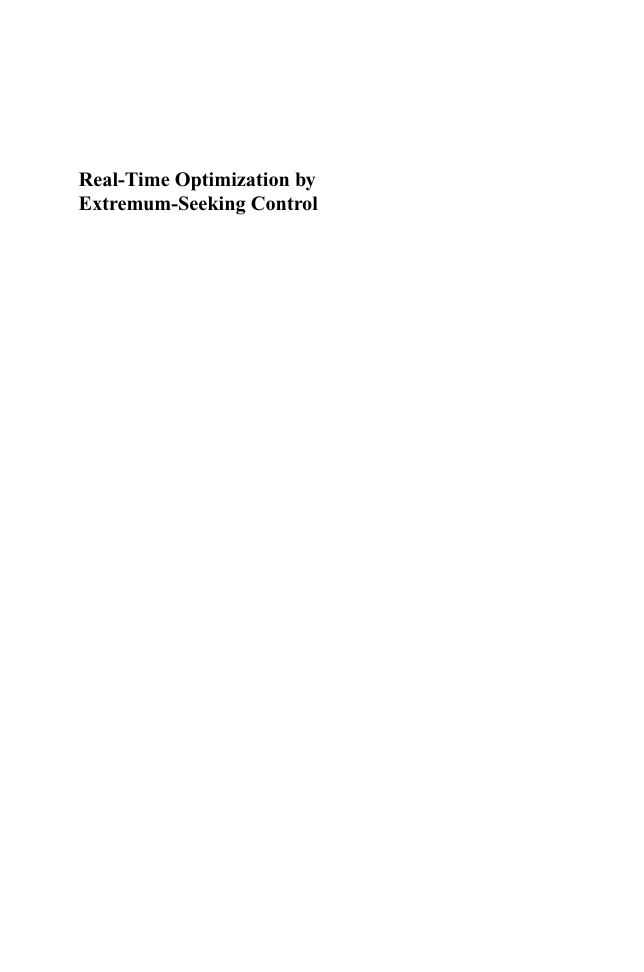
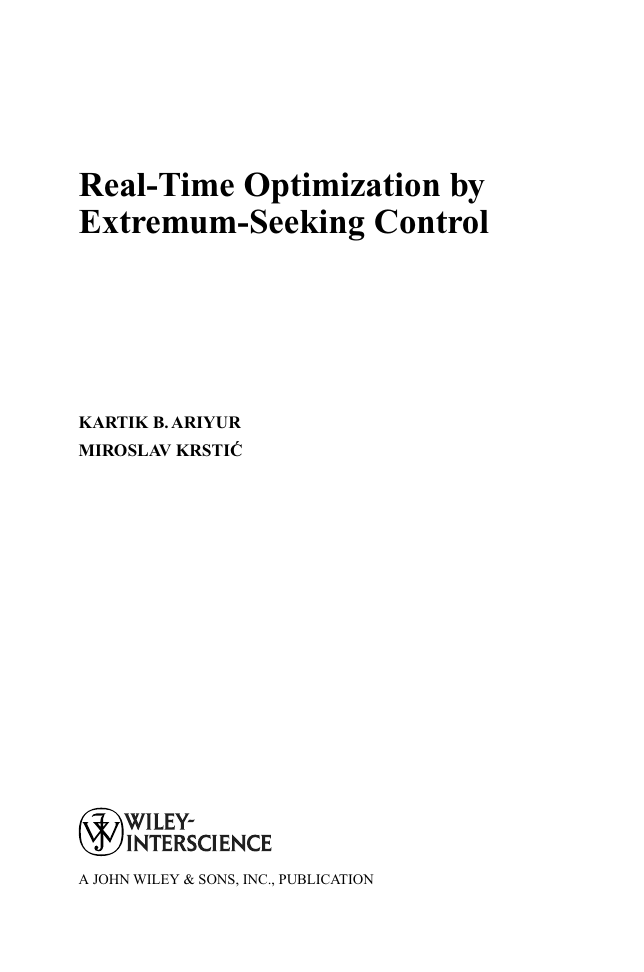

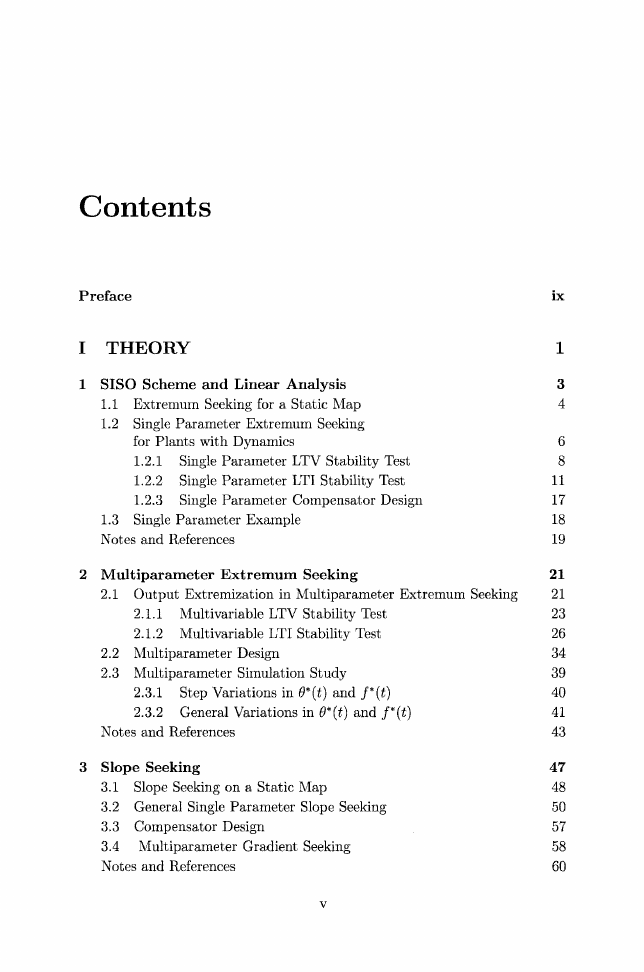
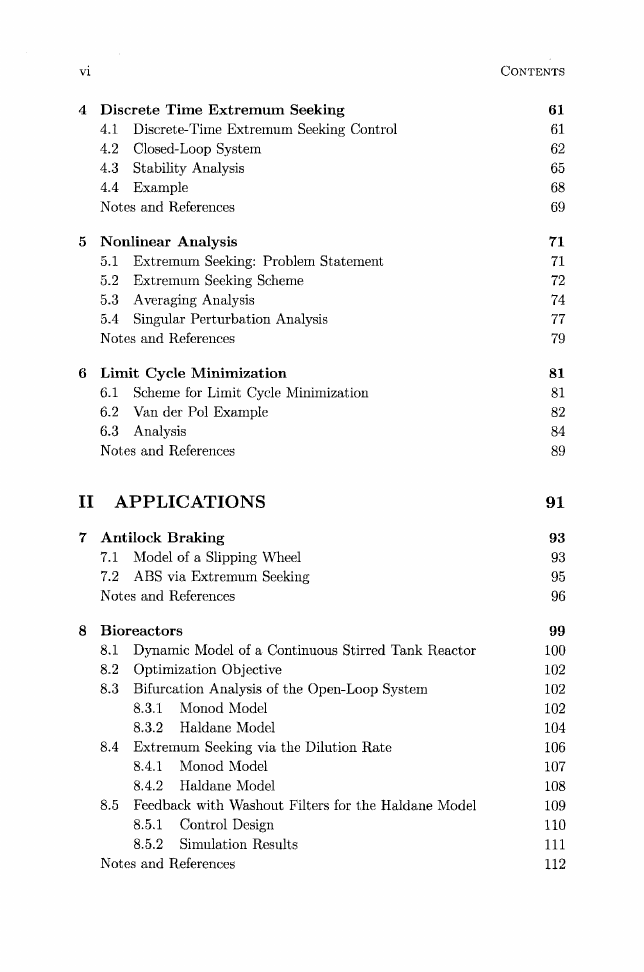
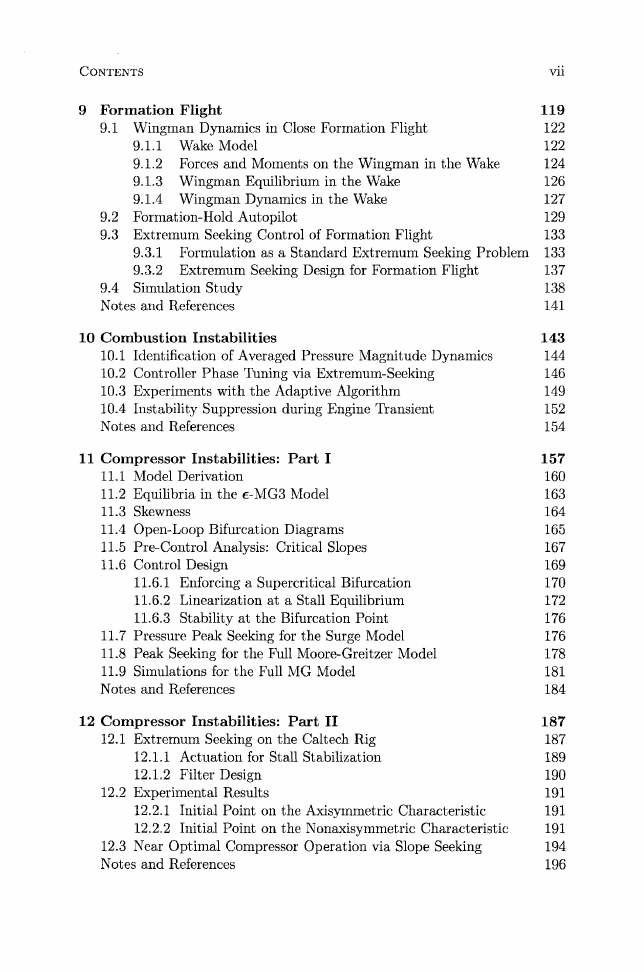
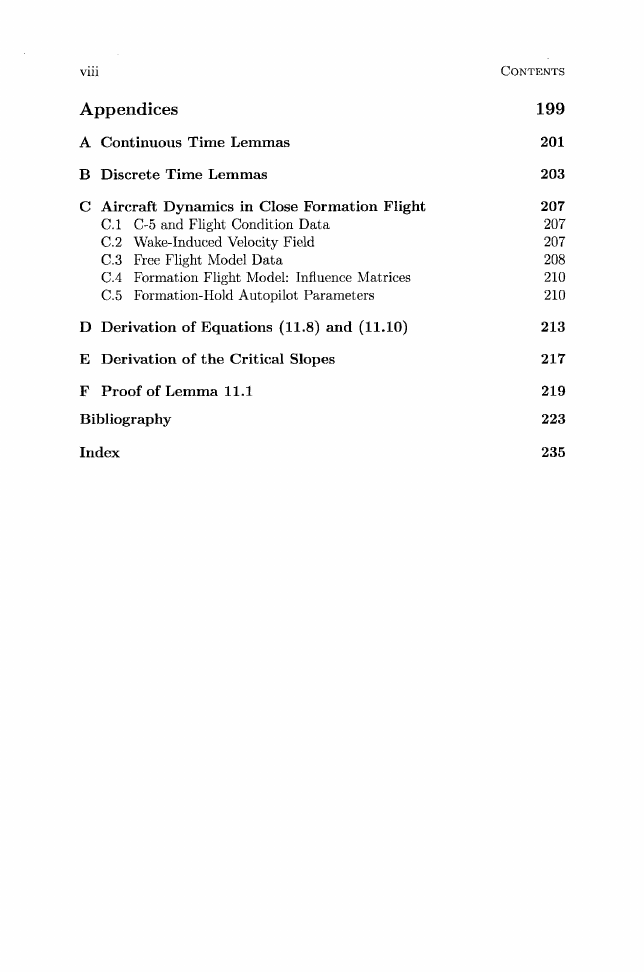
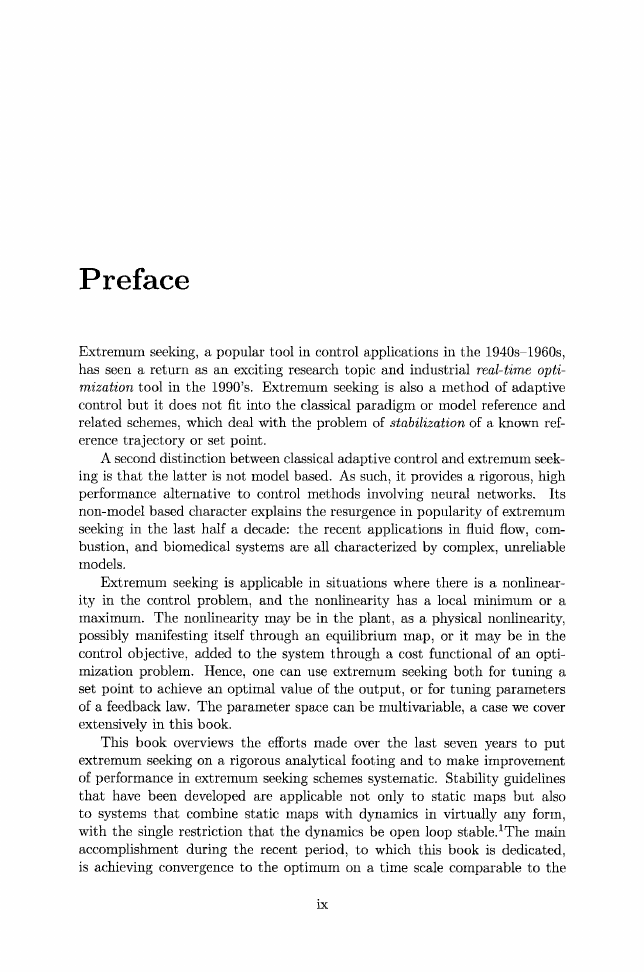








 2023年江西萍乡中考道德与法治真题及答案.doc
2023年江西萍乡中考道德与法治真题及答案.doc 2012年重庆南川中考生物真题及答案.doc
2012年重庆南川中考生物真题及答案.doc 2013年江西师范大学地理学综合及文艺理论基础考研真题.doc
2013年江西师范大学地理学综合及文艺理论基础考研真题.doc 2020年四川甘孜小升初语文真题及答案I卷.doc
2020年四川甘孜小升初语文真题及答案I卷.doc 2020年注册岩土工程师专业基础考试真题及答案.doc
2020年注册岩土工程师专业基础考试真题及答案.doc 2023-2024学年福建省厦门市九年级上学期数学月考试题及答案.doc
2023-2024学年福建省厦门市九年级上学期数学月考试题及答案.doc 2021-2022学年辽宁省沈阳市大东区九年级上学期语文期末试题及答案.doc
2021-2022学年辽宁省沈阳市大东区九年级上学期语文期末试题及答案.doc 2022-2023学年北京东城区初三第一学期物理期末试卷及答案.doc
2022-2023学年北京东城区初三第一学期物理期末试卷及答案.doc 2018上半年江西教师资格初中地理学科知识与教学能力真题及答案.doc
2018上半年江西教师资格初中地理学科知识与教学能力真题及答案.doc 2012年河北国家公务员申论考试真题及答案-省级.doc
2012年河北国家公务员申论考试真题及答案-省级.doc 2020-2021学年江苏省扬州市江都区邵樊片九年级上学期数学第一次质量检测试题及答案.doc
2020-2021学年江苏省扬州市江都区邵樊片九年级上学期数学第一次质量检测试题及答案.doc 2022下半年黑龙江教师资格证中学综合素质真题及答案.doc
2022下半年黑龙江教师资格证中学综合素质真题及答案.doc